|
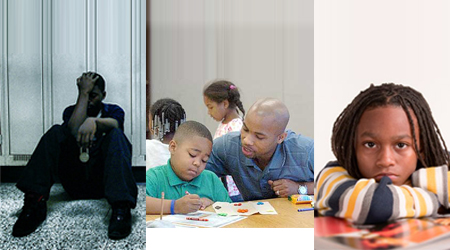
YOUTH DAY (Ages 12–17)
(YOUTH AND EDUCATION)
CULTURAL RESOURCES
Sunday, January 9, 2011
Shauna St. Clair, Guest Cultural Resource Commentator
Pastor of Youth and Young Adults, Twelfth Street Christian Church, Washington, DC
Be sure to read about the High School Success Task Force below.
I. Introduction
This Sunday is dedicated to celebrating youth and education. Today we recognize the importance of nurturing the spiritual growth and Christian foundation of young people in our congregations. This is also a day to remember the essential role African American churches have played not only in providing Christian education, but also in protecting and promoting equal access to broader education in our communities. It is Christian education as well as successful education in the arts and sciences that allows youth to be afforded endless opportunities to improve our world and help the Kingdom come on earth as it is in heaven.
II. Songs that Speak to the Moment
The Song “Get Up” by Mary Mary provides a powerful call to action for listeners to be active and involved. Because they are “one of God’s greatest creations” they have no need to fear anything and no reason for procrastination. These contemporary lyrics invite young people to live, learn, and do more in their world.
Get Up
Layin’ Low
PRESS’N pause
Sleeping long
Slow motion
Gonna do
Shoulda, coulda, woulda done
Excuses
What are you afraid of?
Don’t you know what you’re made of?
One of God’s greatest creations
Take this invitation now
She said
They said
What do you say?
It’s your dreams
your choice
your time
your life
So don’t you
don’t you
miss it
What are you afraid of?
Don’t you know what you’re made of?
One of God’s greatest creations
Take this invitation now
Get Up
‘Cause you can’t stop
Get Up
Got a lot to do
24 hours
almost gone
Get Up
Don’t sit there
Get Up
If you wanna get there
|
Get Up
‘Cause you can’t stop
Get Up
Got a lot to do
24 hours
almost gone
Get Up
Don’t sit there
Get Up
If you wanna get there
Clocks don’t stop and
Time won’t wait
He said
Clocks don’t stop and
Time won’t wait
Welcome to the rest of your life
from now on, just try
to live more, want more, work a little harder
dance more, laugh more, be a little smarter
hug a little longer, love a little stronger
you've been down but now it's time to
Get Up
‘Cause you can’t stop
Get Up
Got a lot to do
24 hours
almost gone
Get Up
Don’t sit there
Get Up
If you wanna get there
Clocks don’t stop and
Time won’t wait (2x)
One more time, Say...
Get Up (x9)1 |
Our second song is an excellent tool to teach youth the power they have in Christ Jesus. While news and popular culture often negatively stereotype African American youth, the lyrics below give youth the opportunity to self-identify as victorious people.
My Name Is Victory
I’ve got evidence
I’ve got confidence
I’m a conqueror
I know that I win
I know who I am
God wrote it in his plan for me
Oh, Oh-Oh, Oh, Oh,
MY NAME IS VICTORY! (2X
God gave me AUTHORITY
To conquer THE ENEMY
He wrote in MY DESTINY
That my name is VICTORY
He said that I’ve OVERCOME
I know I’ve ALREADY WON
He wrote in my DESTINY
That my name is VICTORY
I know who I am
God wrote it in His plan for me
MY NAME IS VICTORY! (2X)
I know my identity, my name is victory!!
Victory...
That’s my name...
Victory....
I KNOW WHO I AM!!!!2
“I Am What God Says I Am” by Tony Small, performed by Maurette Brown-Clark and Jada Simone Clark, is a great song to use during any Youth Day service because our youth must be confident to be successful educationally. The lyrics of this song affirm youth as capable of being all that God has called them to be.
I Am What God Says I Am
I am what God says I am
I can be what God says I’ll be
I am, I can
Be all that God says I can be
Be all that God says I can be
I’m the head, not the tail
I’m above, not beneath
I’m blessed going out
I’m blessed coming in
I am, I can
Be all that God says I can be
Be all that God says I can be
Be all that God says I can be.3
III. Cultural Response to Significant Aspects of the Text
In my introduction I noted the essential role African American churches have played in celebrating, facilitating, and promoting education for youth both in our congregations and within the broader American educational system. Many adult Christians can attest that their early Christian formation took place in small Sunday school classrooms and Vacation Bible school settings. These learning spaces provide children with early foundations in their faith and self identity as followers of Christ and are still much needed.
While the lessons learned under the umbrella of Christian education are vital to the life and future of the Christian church, they are also important in training Christian leaders who will be effective leaders beyond church doors.
Historically, the African American Church’s commitment to Christian education as well as broader secular education has had trenchant impacts on American culture. Within the United States there have been numerous turning points in educational opportunities for people of color. A common thread held by so many of these movements has been the involvement of churches and the involvement of young adults/college students.
An early example of the importance of education to African American faith communities may be seen in the Church’s role in fighting against academic inequalities in schools in the 1950s. In 1954 the Brown vs. Board of Education Supreme Court decision established existing “separate but equal education” in the United States to be unconstitutional. The support for the movement that led to this decision and the subsequent pressure placed on countless school yards around the country was largely rooted in churches. Churches provided leadership, safe places for strategist to meet, and volunteers to participate in these movements. Additionally, churches provided biblical interpretation and preaching that allowed community members to imagine equal treatment that their current society did not offer.
Unfortunately, today we still find ourselves amid crisis and racial disparities in education. In the United States African American students attending some public schools have dropout rates as high as 50 percent.4 If our history is of any value, it may teach us that many progressive social changes are directly dependent on the involvement of religious groups and young people within our communities. In focusing on youth and education, it is often important that we remember the significance of youth being involved in the process of improving educational opportunities. There is a simple quote that comes to mind: “If you have come to help me, you are wasting your time. But, if you have come because your liberation is bound with mine, then let us work together.” This statement was spoken by Aboriginal Australian Activist, Lilla Watson to request social reformist to not only offer benevolent work on the behalf of the “needy,” but to push toward collaborative efforts that can create lasting change.
Certainly, as adults we bring resources and positions that can push forward educational agenda’s in our churches and communities that our youth need. However, if leaders work in closed board rooms and churches offices on the behalf of youth, efforts will always be lacking. The strength of so many movements in our churches and our world has always been the tenacious and courageous involvement of young people who, despite harassment and threats, joined the fight and made decisions like that in Brown vs. Board of Education, a tangible reality. And, it will be the youth and young adults of our churches and local high schools working together with committed adults, who will enable us to overcome the current crisis in education. Following is an idea that your church can use to create youth and young adult education change agents in your community. Whatever you do, do something.
The High School Success Task Force
- Create a High School Success Task Force in your church. Make sure that it includes youth and young adults, persons involved in the education system and parents. Hold a formal ceremony to announce the formation of your task force. Develop a brief and clear mission statement. Develop a catchy motto such as: Failure Is Not an Option, We Help Create Great Schools, Our Works Show We Love Schools etc.;
- Charge your task force with two things in its first year: 1. To ensure that every high school in your church receives the support they need to graduate high school and attend college; this may require homework assistance, financial assistance or even assisting parents; 2. To find the most successful predominately African American high school in your city and in the country. Be sure that they provide a thorough report on these two schools and that the schools have been in existence for at least seven years. This will make it more likely that they have developed best practices templates that they can share with other schools;
- Instead of a summer or fall revival at your church, hold an education revival for at least two days and invite the leaders of both of these schools to come and speak at your church. Advertise this event for all teachers, parents, and students in your city. Make this a big event. Pay speakers what you would normally pay revivalist. Create a video to advertise this event, place it on the Facebook page of all of your church members, do radio announcements and newspaper articles. Advertise the event for at least five months;
- Involve local vendors to have them provide free food. The bigger your crowd, the more interested they will be in providing food. Be sure to thank them by placing their names on event programs. Some may want to serve as event sponsor;
- Contact vendors to have them provide school supplies to a poor school in your community. Research will also have to be done to obtain this information;
- Develop a follow-up plan to determine the next steps for your High School Success Task Force and to make sure that all of your students are on track to graduate; and
- Video your event. Send your video and a write-up about your event to the African American Lectionary. We may post it on our website. Send videos along with event reports to info@TheAfricanAmericanLectionary.org.
IV. Audio Visual Aids
A visual aid that may assist congregations in recognizing the importance education might include a slideshow that shows photographs of youth participating in youth movements, holding protests signs, entering into previously segregated school systems, and attending graduation ceremonies. This could be especially effective if images are of young people from various time periods and if the photos include congregation members.
Example:
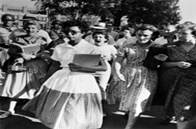
Student Elizabeth Eckford is taunted by whites as she tries to enter Central High School. Online location: http://www.usnews.com/usnews/news/articles/070805/13rock.htm accessed 5 December 2010
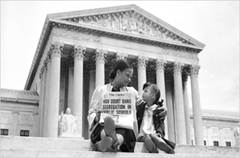
Mother with daughter on the steps of the Supreme Court holds newspaper announcing Brown vs. Board of Education decision. Online location:
http://blog.mywonderfulworld.org/2009/02/february-is-black-history-month.html accessed 5
December 2010
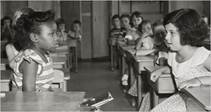
The Supreme Court’s decision in Brown v. Board of Education integrated the schools. But today its meaning is at issue. Here, the first day of desegregation, on Sept. 8, 1954, at Fort Myer Elementary School in Fort Myer, VA. Online location:
http://www.nytimes.com/2006/12/10/weekinreview/10liptak.html?_r=1FIRST DAY accessed 5 December 2010
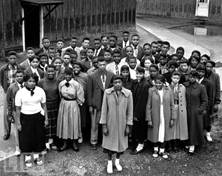
'Dorothy Davis, et al. v. County School
Group portrait of some of the more than 100 students named in the legal case 'Dorothy Davis, et al. v. County School Board of Prince Edward County, Virginia,' a lawsuit filed to seek, initially, repairs for Robert Moton High School, a segregated school in Farmville, Virginia, March 1953. The case was later, on appeal, attached to the landmark 'Brown vs. Board of Education' case. Among those pictured is Dorothy E. Davis (center, with glasses), for whom the suit was named. Online location: http://www.life.com/image/50654228 accessed 5 December 2010
V. Stories and Illustrations
In his book “God and the Disinherited,” Howard Thurman shares a story from his grandmother. His grandmother grew up in slavery during a time period when it was often illegal for African Americans to read. She shared with him that there was a white minister (her slave master would send a white minister to the slaves) who would regularly read the biblical “text: ‘Slaves, be obedient to them that are your masters…, as unto Christ.’’’ His grandmother promised herself that if she “ever learned to read and if freedom ever came, I would not read that part of the Bible.”5
In keeping her promise, when her grandson came to read Scripture to her, she would not let him read these passages. Thurman uses this story to show that Scripture can be a dangerous weapon when it used in the hands of the powerfully ignorant and against others who are oppressed. This story is a powerful reminder of the importance of a good education. Once our children are educated and can think critically for themselves, whether it be through the Bible, a science text, or a philosophy book, television, or the web, no one can feed them information that they will accept without thorough examination and critical analysis.
VI. Making it a Memorable Learning Moment
The Smithsonian as an Education Resource
The Smithsonian is our national library. Since our taxes support it why not use it. The Smithsonian has one of the finest and largest collections of African American books, arts, photographs, and historic music. They also provide lessons plans that teachers in public and church schools can use.
To find education resources for all age groups, go to
www.smithsonianeducation.org/educators/resource_library/African_American_Resources.html
Literary Resources
- The Children. Halberstam, David . New York, NY: The Ballantine Publishing Group, 1998.
- Black Church Beginnings. Mitchell, Henry H. Grand Rapids, MI: William B. Eerdmans Publishing Company, 2004.
- Family Life and School Achievement: Why Poor Black Children Succeed or Fail. Clark, R.M. Chicago: University of Chicago Press, 1983.
- Full-service Schools: A Revolution in Health and Social Services for Children, Youth, and Families. Dryfoos, J.G. San Francisco, CA: Jossey-Bass, 1994.
Notes
1. Mary, Mary. “Get Up. Get Up.” Get Up. New York, NY: Columbia/Sony, 2008.
2. Nelson, Jonathan. “My Name Is Victory.” Right Now Praise. New York, NY: Integrity/Columbia, 2008.
3. Brown-Clark, Maurette, and Jada Simone Clark. “I Am What God Says I Am.” Lyrics, Tony Small. The Dream. Atlanta, GA: Atlanta International, 2007.
4.Orfield, Losen G., D.J.Wald, and C.B. Swanson. “Losing Our Future: How Minority Youth Are Being Left Behind By the Graduation Rate Crisis.” Cambridge, MA: The Civil RightsProject at Harvard University. (2004); See Losen, D.J. “Racial Inequity in Graduation Rates.”Research presented during Connect for Kids and National EducationAssociation conference call on the Dropout Crisis (2005,December); “The African American graduation rate in 2002 to be 56%, Latinos 52%, and Whites 78%.” Greene, Jay P., and Marcus A. Winters. “Public High School Graduation and College-Readiness Rates: 1991–2002.” Education Working Paper No. 8 February 2005. Manhattan Institute for Policy Research. Online location: http://www.manhattan-institute.org/html/ewp_08.htm accessed 8 December 2008
5.Thurman, Howard. God of the Disinherited. Boston, MA: Beacon Press, 1976.
|